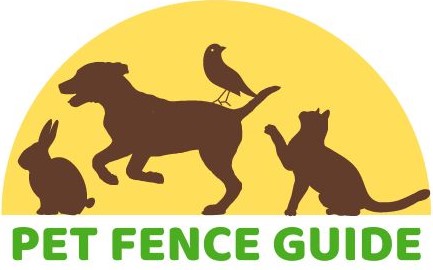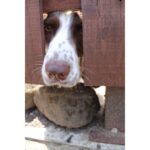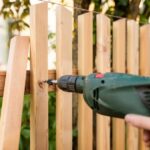Will invisible fence work under concrete? A query asked by some of my readers repeatedly. So let’s discover the answer today. Invisible fences, also known as underground or electric dog fences. They have become popular for pet owners seeking a safe and effective way to keep their furry friends within designated boundaries.
These systems rely on buried wires and electronic collars to train pets to stay within a defined area without traditional physical fences. This comprehensive article will explore the feasibility and challenges of installing an invisible fence under concrete.

Understanding Invisible Fence Basics:
Table of Contents
ToggleBefore delving into whether invisible fences can function beneath concrete, it’s essential to understand the fundamental components and principles of these systems:
- Transmitter and Receiver: Invisible fence systems consist of a transmitter unit that connects to the boundary wire and a receiver attached to the pet’s collar. The transmitter emits a signal along the wire, defining the containment area, while the receiver on the collar alerts or corrects the pet when it approaches the boundary.
- Boundary Wire: The boundary wire is a critical part of the system. It can be buried underground, placed on the ground, or attached to existing fences to create the boundary.
- Signal Types: Invisible fences use radio signals or wired systems to communicate between the transmitter and receiver. Wired systems are more stable and less prone to interference, making them a popular choice.
- Correction Mechanisms: When a pet approaches the boundary, the receiver emits a warning sound or, in some systems, a mild static correction. This trains the pet to associate the boundary with an unpleasant sensation, discouraging them from crossing it.
Will Invisible Fence Work Under Concrete? The Challenge of Concrete:
Concrete, with its dense nature, presents a unique set of challenges when it comes to the installation and operation of invisible fence systems. These challenges revolve around signal interference and the difficulties associated with burying the boundary wire beneath concrete surfaces.
1. Signal Interference:
One of the foremost challenges in using invisible fence systems under concrete is signal interference. Invisible fences typically rely on radio signals or electromagnetic fields to establish and maintain the pet’s containment boundaries. Concrete, as a dense material, can significantly attenuate these signals, hindering their effective transmission.
Concrete as a Barrier: When the boundary wire is buried near or under concrete surfaces, the concrete acts as a formidable barrier to the radio signals emitted by the system’s transmitter. This attenuation can lead to signal degradation and result in an unreliable boundary for the pet. The signal may struggle to penetrate the concrete, leading to erratic and imprecise boundaries.
Unpredictable Boundaries: The consequences of signal interference in an invisible fence system can be problematic. Pets may experience inconsistent corrections or warnings, as the signal may weaken or become distorted when passing through or around concrete structures. This unpredictability can make it challenging for pet owners to trust that their furry companions are safely contained within the designated area.
2. Installation Difficulty:
Burying the boundary wire beneath concrete surfaces introduces a layer of complexity to the installation process of invisible fence systems. Concrete surfaces, such as driveways, sidewalks, or patios, are typically not designed with underground wiring in mind. Several factors contribute to the difficulty of this task:
Concrete Composition: The composition of concrete can vary widely, with different mixes and additives used for specific applications. Some types of concrete are denser and more challenging to work with than others, further complicating the installation process.
Digging and Trenching: Installing the boundary wire beneath concrete requires digging a trench or groove to accommodate the wire. Depending on the depth and length required, this can be labor-intensive and time-consuming.
Professional Expertise: Given the complexities of burying wires under concrete, it is often advisable to seek the expertise of professional installers. They have the knowledge and equipment necessary to ensure the job is done correctly, minimizing the risk of damage to the concrete or the wire.
Future Maintenance: Another consideration is future maintenance or repairs. If the boundary wire needs servicing or replacement, accessing it beneath concrete can be a costly and disruptive endeavor. Proper planning and installation techniques can help mitigate these challenges.
Will Invisible Fence Work Under Concrete? Factors to Consider:
Installing an invisible fence system beneath concrete surfaces is a complex endeavor that demands careful planning and execution. Several key factors come into play when navigating this challenging task. Here, we delve into these factors, highlighting the critical considerations that can make or break the success of your invisible fence installation under concrete.
1. Type of System:
The choice of the invisible fence system is a foundational consideration. Not all systems are created equal, and the type you select can significantly impact its performance under concrete.
Wired vs. Radio Signal-Based Systems: Wired systems, often referred to as underground or in-ground fences, tend to perform better under concrete than radio signal-based systems. This is because wired systems utilize a physical boundary wire buried in the ground, which provides a stable signal. Radio signal-based systems, on the other hand, may struggle with signal interference from the concrete, leading to erratic boundaries and containment issues.
2. Signal Strength:
The strength of the signal generated by the transmitter is a crucial determinant of system performance. High-quality invisible fence systems often offer adjustable signal strength settings, allowing pet owners to fine-tune the signal to compensate for the potential interference posed by concrete.
Signal Boost: In cases where concrete is a significant barrier, being able to boost the signal strength can be invaluable. This feature allows the signal to penetrate the concrete more effectively, ensuring consistent and reliable boundaries.
3. Depth of Bury:
When burying the boundary wire beneath concrete surfaces, the depth of burial is a critical factor. Ideally, the wire should be placed as close to the surface as possible without risking damage.
Shallower is Better: Burying the wire closer to the surface minimizes the distance the signal must traverse through the concrete. This proximity enhances system performance and reduces the likelihood of signal attenuation.
4. Signal Penetration:
Not all concrete is created equal, and different types of concrete may allow for varying degrees of signal penetration.
Concrete Density: The density of the concrete matters. Concrete with a lower density, such as lightweight concrete, may interfere less with the signal, making it a more favorable choice for installations involving invisible fences.
5. Wire Protection:
Protecting the boundary wire is essential to ensure its longevity and functionality, especially when buried under concrete.
Conduit or PVC Piping: To shield the wire from potential damage, consider encasing it in conduit or PVC piping before burying it. This protective layer not only guards against physical damage but also simplifies future maintenance and repairs.
6. Professional Installation:
Installing an invisible fence system under concrete is a complex and intricate task that demands a high level of expertise. It’s often advisable to seek professional installation services, particularly from experts experienced in such installations.
Experience Matters: Professionals who specialize in invisible fence installations are well-versed in the nuances of working with concrete surfaces. They have the knowledge and equipment necessary to ensure the system functions optimally, minimizing the risk of installation errors.
In conclusion, successfully installing an invisible fence system under concrete hinges on a thorough understanding of these critical factors. The type of system chosen, signal strength adjustments, burial depth, concrete composition, wire protection measures, and professional installation all play pivotal roles in determining the system’s performance and reliability. By carefully considering and addressing these factors, pet owners can create a safe environment for their beloved animals while preserving the integrity of their concrete surfaces.
Will Invisible Fence Work Under Concrete? Alternatives to Burying Under Concrete:
If you’re concerned about the challenges posed by concrete, there are alternatives to consider:
- Attach to Existing Fencing: Instead of burying the wire under concrete, you can attach it to an existing fence. This eliminates the need to deal with concrete interference and simplifies the installation process.
- Adjust Containment Boundaries: If burying the wire under concrete is unavoidable, consider adjusting the containment boundaries to avoid the concrete areas. This may require creative planning and layout adjustments.
- Use Additional Pet Training: In cases where an invisible fence isn’t feasible under concrete, combining it with traditional training methods can help ensure your pet understands their boundaries.
Conclusion:
Invisible fences can work under concrete, but it requires careful planning and consideration of the system type, signal strength, and installation method. While concrete can pose challenges to signal transmission, these challenges can be overcome with the right equipment and expertise.
Will Invisible Fence Work Under Concrete? If you’re unsure about installing an invisible fence under concrete, consult with a professional installer to assess your specific situation and provide the best solution for your pet’s containment needs. Ultimately, with the right approach, you can successfully use an invisible fence to create a safe environment for your furry friend, even when concrete is involved.

FAQs
What are the negatives of an Invisible Fence?
- Risk of Escape: While invisible fences can be effective, some determined or highly motivated pets may learn to tolerate the mild static corrections and escape the containment area. This can lead to pets roaming freely, potentially putting them in harm’s way or causing issues with neighbors.
- Lack of Protection from Intruders: Invisible fences are designed to keep pets in, not to keep other animals or people out. Intruders, such as stray animals or wildlife, can freely enter the containment area, potentially causing conflicts or harm to your pet.
- Limited Training Required: Properly training a pet to understand the boundaries of an invisible fence is crucial for its effectiveness. Neglecting this aspect or using the system without proper training can lead to confusion and anxiety for the animal.
- Potential for Fear or Anxiety: Some pets may develop fear or anxiety related to the invisible fence system, associating the discomfort of the static correction with the outdoor environment. This can affect their overall well-being and behavior.
- Battery and Collar Maintenance: Invisible fence systems require regular maintenance, including replacing batteries in the pet’s collar and checking the system for any issues. Neglecting maintenance can lead to system failure and compromised containment.
- Not Suitable for All Pets: Invisible fences may not be suitable for all pets, particularly those with certain temperaments or medical conditions. The stress or anxiety caused by the system may not be worth the benefits for some animals.
- Initial Cost: The installation of an invisible fence system can be costly, involving the purchase of equipment and, in some cases, professional installation. This initial investment may be prohibitive for some pet owners.
- Limited Containment Area: The size and shape of the containment area in an invisible fence system are typically limited by the configuration of the boundary wire. This may not be suitable for pet owners with larger properties or irregularly shaped yards.
In summary, while invisible fences can be a viable option for pet containment in certain situations, it’s important to weigh the negatives against the positives. Responsible pet ownership involves considering the individual needs and behavior of your pet and ensuring that any containment method used is safe and appropriate for them.
What happens if a dog crosses an invisible fence?
When a dog crosses an invisible fence, several things can happen, depending on the type of invisible fence system in use:
- Warning Signal: In many invisible fence systems, the first response to a dog approaching or crossing the boundary is a warning signal. This can be an audible tone or a vibration emitted from a receiver on the dog’s collar. The purpose of this warning is to alert the dog that it is getting too close to the boundary.
- Static Correction: If the dog continues to approach or tries to cross the boundary after receiving the warning signal, some systems deliver a mild static correction or stimulation through the collar. This static correction is often described as feeling similar to a static shock from a doorknob. It discourage the dog from crossing the boundary.
- Correction Intensity: The intensity of the static correction can typically be adjusted on the collar to suit the dog’s size and temperament. The correction is meant to startle the dog and deter it from proceeding further, not to cause harm or significant pain.
- Return to Safe Zone: Ideally, after experiencing the static correction, the dog will retreat from the boundary and return to the safe zone within the containment area. This reinforces the association between the warning signal or static correction and the boundary limits.
- Training: For invisible fence systems to be effective, proper training is crucial. Most systems come with a training program that involves teaching the dog to understand the boundaries and the consequences of crossing them. Consistent and patient training helps the dog learn to stay within the designated area.
- Varying Reactions: Dogs may react differently to the static correction. Some may quickly learn to avoid the boundary, while others may take more time to grasp the concept. Pet owners need to monitor their dogs during the training phase and provide positive reinforcement for staying within the safe zone.
- Safety Features: Many modern invisible fence systems include safety features to ensure that the static correction is not continuous or excessive. For example, the correction often stops after a certain duration to prevent overstimulation.
It’s important to note that, while invisible fence systems can be effective in containing dogs within a designated area, they may not be suitable for all dogs. Some dogs may not respond well to the static correction, while others may become anxious or stressed when approaching the boundary. Responsible pet ownership involves considering your dog’s temperament and needs and ensuring that the use of an invisible fence is both safe and appropriate for your specific pet. Proper training and supervision are key to the success of these containment systems.







